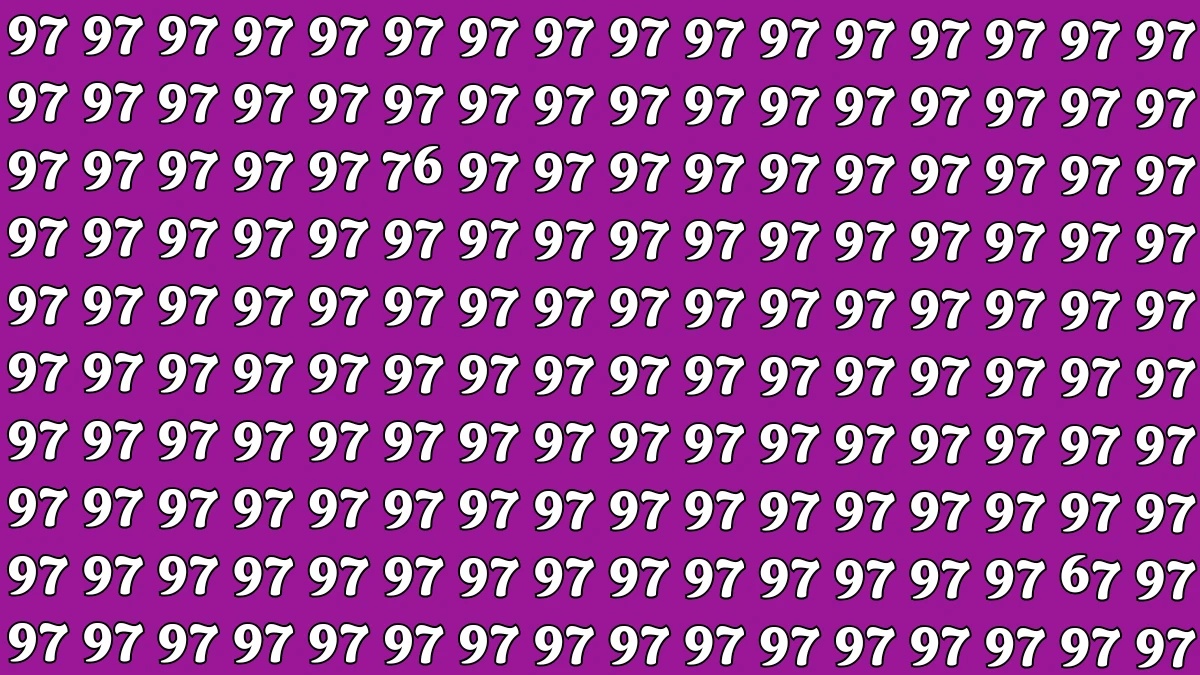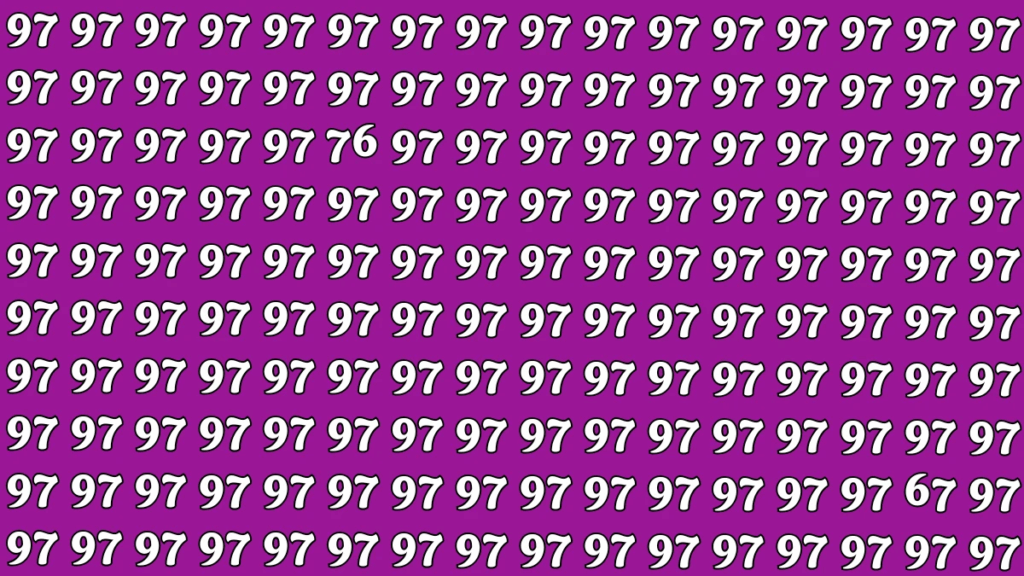Are your eyes sharp enough to spot differences in a sea of similar numbers? Optical illusions are more than just fun—they’re scientifically proven to boost brain activity, concentration, and pattern recognition. In this challenge, your task is simple yet tricky: spot the numbers 76 and 67 hidden among countless 97s—but do it in under 7 seconds.

This seemingly simple puzzle is taking the internet by storm. It’s an excellent way to exercise your brain while enjoying a bit of light-hearted competition with friends or family. So, if you’re ready to test your vision, keep reading—and get ready to focus.
Quick Summary: Optical Illusion Challenge
Feature |
Details |
|---|---|
Puzzle Type |
Optical Illusion Number Puzzle |
Challenge |
Find numbers 76 and 67 hidden among 97s |
Time Limit |
7 Seconds |
Purpose |
Visual skill test, brain exercise, entertainment |
Difficulty |
Moderate to High |
Best For |
All age groups, puzzle lovers, students, professionals |
Where to Try |
Shared as image puzzles online and on social media platforms |
Official Puzzle Source |
What Is This Optical Illusion Puzzle?
Optical illusions are images or visual patterns that deceive the brain, making us see things that aren’t immediately obvious. In this case, you are presented with an image full of repeating numbers—97—and asked to find two numbers that break the pattern: 76 and 67.
Why is this difficult? Because the digits 6, 7, and 9 have similar curves and spacing when printed in certain fonts, making them easily confused at a glance. Add to this the time pressure of just 7 seconds, and your mind must act fast to differentiate subtle visual anomalies.
Why Optical Illusions Are Beneficial
Optical illusion puzzles aren’t just entertaining; they also provide cognitive benefits, such as:
- Enhanced Attention to Detail: Spotting slight differences trains the brain to be more observant.
- Faster Cognitive Processing: Processing visual patterns quickly improves mental agility.
- Stress Relief: Focusing on puzzles can serve as a break from daily stressors.
- Visual Memory Enhancement: Repeated exposure to similar puzzles strengthens pattern recognition.
These are particularly beneficial for students, professionals in design or tech, or anyone who wants to stay mentally sharp.
The 7-Second Challenge: How to Attempt the Puzzle
Before you begin, here are a few quick tips:
- Minimize Distractions: Clear your surroundings to focus purely on the image.
- Use Full Screen (If on Mobile or PC): Viewing the image in larger format helps notice fine details.
- Scan in a Pattern: Avoid randomly looking around. Try scanning row-by-row or column-by-column.
- Set a Timer: Make the challenge real by setting a 7-second countdown.
Then, begin your search!
What Makes This Puzzle Tricky?
The difficulty of this illusion lies in its simplicity. Here’s why:
- Visual Overload: The pattern of 97 is repeated dozens of times, making it hard for your brain to isolate anomalies.
- Digit Similarity: Numbers like 6, 7, and 9 have similar upper loops or lower curves.
- Short Time Frame: The 7-second rule pushes your focus and pressure tolerance.
This kind of design is a classic example of what experts call “cognitive interference”, where your brain is so overwhelmed by similar patterns that it delays recognition of the different ones.
Optical Illusion Solution: Where Are the Numbers 76 and 67?
If you couldn’t locate both numbers within the time limit, don’t worry—you’re not alone. Many people find such puzzles challenging under time constraints. Here’s the answer:
- Number 76: Found near the top-center of the image.
- Number 67: Located toward the bottom-right section of the image.
Both numbers break the flow of 97s by altering either the first or second digit. Once identified, they appear almost obvious—but only after the illusion wears off.
How Do These Puzzles Work Psychologically?
Psychologists suggest that these puzzles work due to the brain’s tendency to create “visual templates.” When your brain sees multiple similar patterns (like 97s), it automatically starts to expect the same thing again and again, ignoring outliers. This “cognitive predictability” is what makes it hard to catch different elements—even when they’re right in front of your eyes.
Who Should Try These Puzzles?
These visual challenges are perfect for:
- Students: To improve concentration and analytical thinking.
- Working Professionals: As a quick brain break to enhance focus.
- Puzzle Enthusiasts: Who enjoy logic games and brain teasers.
- Older Adults: For maintaining cognitive sharpness in a fun way.
They can also be shared as competitive mini-games on social media platforms like Instagram, WhatsApp, or LinkedIn for some interactive fun.
FAQs About This Optical Illusion Puzzle
Q1. How long should it take to solve this?
A: Ideally under 7 seconds, but even 15–30 seconds is considered good performance.
Q2. Are these puzzles good for brain development?
A: Yes, they help improve memory, attention, and problem-solving skills.
Q3. Can kids try this puzzle?
A: Absolutely. It’s simple, number-based, and safe for all ages.
Q4. How often should I practice these puzzles?
A: Practicing 1–2 puzzles daily can significantly improve visual cognition.
Q5. What if I couldn’t find the numbers?
A: That’s okay—your brain is still training. Try again without the timer or zoom in slowly.
Q6. Where can I find more puzzles like this?
A: Many puzzle websites and newspapers like Jagran Josh, Times of India, or apps like Brain Test and Lumosity feature such illusions.
Q7. Do these illusions work the same for everyone?
A: Not exactly. Visual acuity, focus, and mental fatigue all play roles. Everyone processes them differently.
Conclusion: Did You Pass the Test?
Whether or not you spotted the numbers within 7 seconds, you’ve already given your brain a meaningful workout. These optical illusions aren’t just internet trends—they are valuable tools for sharpening observation skills, enhancing memory, and even relaxing after a long day.
So the next time you scroll through social media and see one of these mind-bending challenges, don’t skip it. Accept the challenge. Time yourself. And most importantly—have fun!
For More Information Click Here










